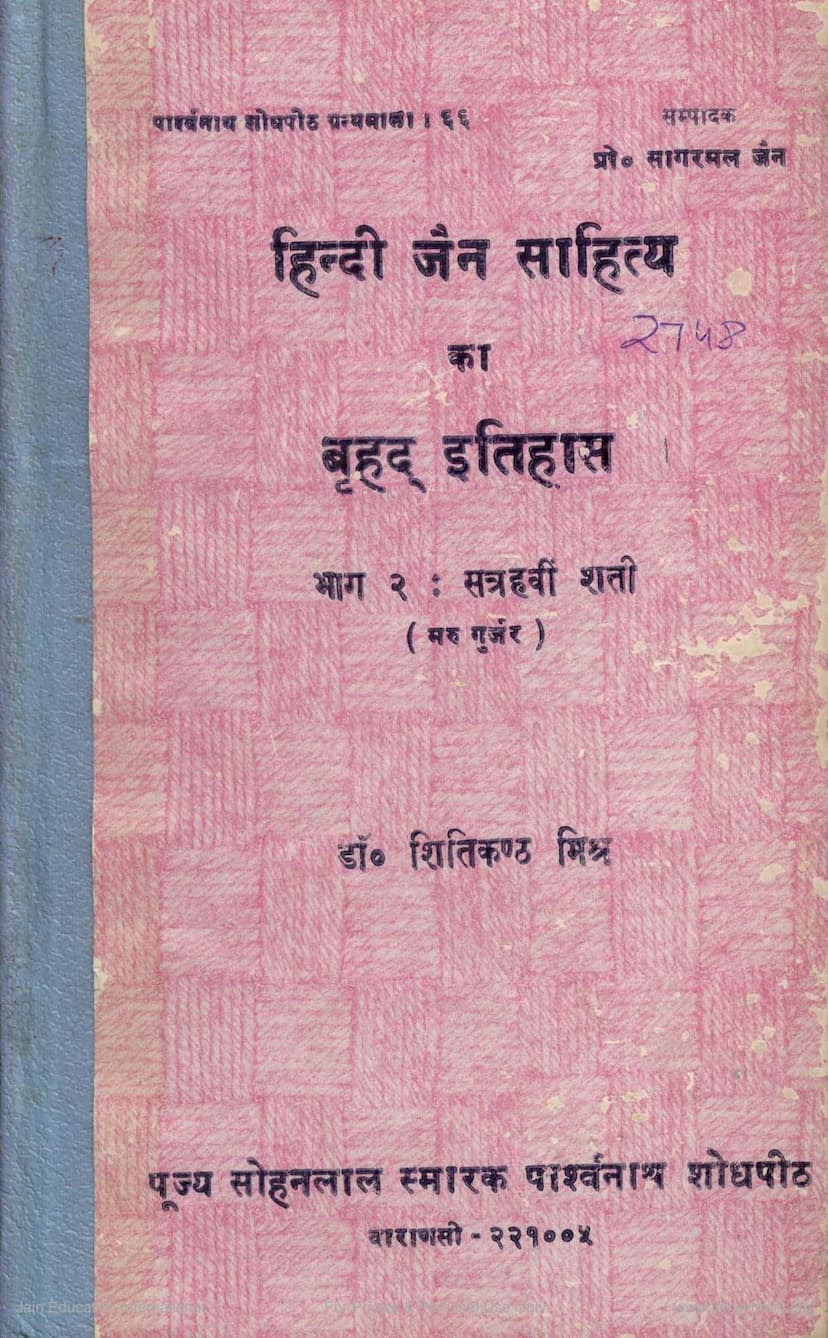Hindi Jain Sahitya Ka Bruhad Itihas Part 2
Added to library: September 1, 2025

Summary
Here's a comprehensive summary of the provided Jain text, "Hindi Jain Sahitya ka Bruhad Itihas Part 2" by Shitikanth Mishr, focusing on the 1trh century Vikram Samvat:
Overall Scope and Purpose:
This book, the second volume in a larger series on the history of Hindi Jain literature, meticulously details the contributions of Jain poets and writers during the 17th century of the Vikram era (approximately 1542-1642 CE). The author, Dr. Shitikanth Mishra, acknowledges building upon the foundational work of scholars like Mohanlal Dalichand Desai and Agarchand Nahata, while also incorporating material from other sources such as Dr. Kasturchand Kasliwal. The book aims to provide a comprehensive and impartial overview of this period's Jain literary output, recognizing the significant devotional and didactic nature of most works.
Key Themes and Characteristics of 17th Century Jain Literature:
- Devotional and Didactic Focus: The literature is predominantly religious, aiming to propagate Jain principles like non-violence (ahimsa), non-possession (aparigraha), ethical conduct, and the doctrine of karma.
- Influence of the Bhakti Movement: The 17th century witnessed a strong influence of the pan-Indian Bhakti movement. This is evident in the prevalence of devotional poetry dedicated to Jain Tirthankaras, gurus, and influential figures, often characterized by tenderness and eloquence. This period is considered a "golden age" for Jain devotional literature in the Maru-Gurjar region.
- Vastness and Diversity: Despite the common devotional theme, the literary output showcases remarkable diversity in poetic forms, including ras, chaupai, charitra (biographical narratives), stotras (hymns), fagu (seasonal poems), and charchari (religious songs).
- Historical and Biographical Content: Many works served as historical records, detailing the lives of influential Jain Acharyas, historical personalities, and significant events, thus reflecting the Jain writers' interest in history and their commitment to accuracy.
- Linguistic Landscape: While the primary focus is Hindi Jain literature, the language often exhibits a blend of Hindi, Gujarati, and Rajasthani, characteristic of the "Maru-Gurjar" linguistic style. This linguistic fusion is a testament to the cultural exchange of the era.
- Gady (Prose) Development: While poetry dominated, prose also saw significant development, with translations, commentaries (tika), and balavbodh (simplified explanations) being produced.
Contextual Background (Upodhghat**):**
The introductory section provides a crucial socio-political and cultural backdrop for the 17th century:
- Political Situation: The era was marked by the Mughal Empire's consolidation under emperors like Akbar and Jahangir. This period saw relative peace, administrative stability, and a degree of religious tolerance, which fostered cultural synthesis. The text highlights the decline of earlier Sultanates and the establishment of a more unified governance structure.
- Social and Economic Conditions: While the Mughal administration aimed for order, societal disparities persisted. The upper classes enjoyed wealth, while the lower strata faced hardship. The text notes the influence of Sufism and Vaishnavism in bridging communal divides, setting the stage for Akbar's inclusive policies.
- Akbar's Religious Policy and Jain Interaction: The book emphasizes Akbar's liberal religious outlook and his interactions with prominent Jain Acharyas like Hiravijaya Suri and Jinchandra Suri. These interactions led to significant concessions for the Jain community, including the abolition of certain taxes and the promotion of non-violence. The author highlights how these relationships facilitated the spread and recognition of Jain literature.
- Cultural Synthesis: The era facilitated a rich cultural amalgamation, influencing art, literature, and societal norms. The contribution of Jain scholars and patrons in this cultural milieu is also noted.
Detailed Literary Landscape:
The bulk of the book is dedicated to cataloging and analyzing the works of hundreds of Jain authors from the 17th century. The text meticulously lists authors alphabetically, providing biographical details (where available), their philosophical affiliations (e.g., Tapagachha, Kharatragachha), significant works with their composition dates and manuscript locations, and often quotes exemplary verses.
Notable Authors and Works Highlighted:
The text presents an extensive list of authors, many of whom are discussed in detail. Some of the most prominent include:
- Mahatma Anandghan: Celebrated for his spiritual and devotional poetry, blending Hindi and Gujarati influences.
- Banarasidas: Renowned for his autobiography "Ardha Kathanak" and the philosophical drama "Samayasar Natak," considered masterpieces of Hindi Jain literature.
- Hiravijaya Suri & Jinchandra Suri: Highly influential Acharyas who interacted with Emperor Akbar, significantly boosting the social standing and literary patronage of the Jain community.
- Mahoapadyaya Samaysundar: A prolific writer of immense scholarly and literary caliber, whose works spanned Sanskrit, Prakrit, and Maru-Gurjar languages.
- Rishabhadas: A significant poet whose vast output includes numerous rasas and devotional works, showcasing rich descriptions of contemporary life and society.
- Kushallabh: Famous for his popular folk literary works like "Dholamarur Duha" and "Madhavanal Kamakandala," alongside Jain religious narratives.
- Kanakasundar, Kankasom, Meghraj, Vidychand, etc.: Numerous other scholars and poets are detailed, each contributing to the rich tapestry of 17th-century Jain literature.
Methodology and Contribution:
Dr. Mishra's work is characterized by:
- Comprehensive Coverage: The book aims for exhaustive coverage of authors and their works from the specified century.
- Scholarly Rigor: It relies on established sources and critical analysis, acknowledging previous scholarship.
- Impartial Presentation: The author strives for an objective presentation of Jain literature, free from sectarian bias.
- Detailed Entries: Each author entry includes biographical information, philosophical lineage, and descriptions of their works, often with composition dates and textual examples.
- Extensive Bibliography: The book includes a substantial list of reference works, underscoring the depth of research.
Conclusion:
"Hindi Jain Sahitya ka Bruhad Itihas Part 2" stands as a monumental achievement in documenting the vibrant and diverse literary contributions of the Jain community in the 17th century Vikram Samvat. It serves as an invaluable resource for scholars of Jainism, Indian literature, and cultural history, illuminating a significant period of religious and artistic expression. The book is a testament to the enduring legacy of Jain intellectual and literary traditions.